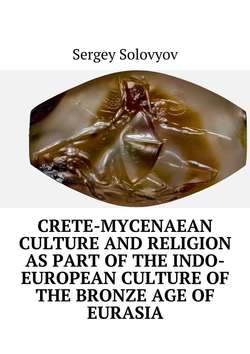Читать книгу Crete-Mycenaean culture and religion as part of the Indo-European culture of the Bronze Age of Eurasia - Сергей Соловьёв - Страница 3
Contents. Introduction
ОглавлениеHellas and Hellenism. Tain meanders, acanthus and palmettes.
Date of the Treasure of Schliemann Tactics of the Achaean chariots in battle Chariot fighters of Ancient Greece of the Bronze Age.
Lenses and products from rock crystal. Discoveries of the Bronze Age of the Century from Troy, Mycenae and Crete.
On the stela No. 1428 from the grave circle «A» Mycenae, the meaning of this image, and the possible translation of the pictorial relief.
Ritual cups on a fresco from the grave of Rehmir. Buckets as one of the signs of Indo-European culture.
Trident, as one of the iconic symbols of Indo-European culture.
The discovery of iron is ancient. Ethiopians and Colchis. Ancestral home of Ancient Greece and the Caucasus.
The double helix as a cultural and religious symbol in the Indo-European culture, and its connection with Acanthus, Meander and Palmetta.
Ilios and Leto, like the deities of the sun and ice, and the gods-twins Apollo and Elisia.
Acanthus in the Middle Ages.
Griffins, lions and sphinxes in the Knossos and Pylos palaces of the Crete-Mycenaean culture. The serpent (Issaya) in the hand of Elisia is the attribute, meaning and meaning of this symbol in Indo-European culture.
Image of the Priest King from the island of Crete. Apollo and Krishna. Identification of this relief as the oldest cultural and religious image of Apollo-Krishna, as a common Indo-European deity of the Bronze Age era.
The world tree. Guardians of the World Tree – Apollo (Ill) and Elecia (Helen) in ancient Greek mythology.
Delphic oracle Warriors led by Ill in new lands and in just wars Combes with helmets of warriors and their meaning.
The oldest Indo-European myths in the tales of Hans Christian Andersen. Apollo and Elisius. Akant, Meander and Palmetta.
Swastika, left and right. The true meaning of these signs.
The Archangel Cathedral of the Moscow Kremlin. Feat of the creativity of Alevizo the New. Acanthus and Palmetta on the walls of the Cathedral.
Regular parks.
Horsemen of the Apocalypse. Eschatological views in Indo-European culture. The oldest relief with the image of the Battle on the Kalinov Bridge with a three-headed serpent.
Lamb in the Indo- European religions.
Secret signs on pedestals of garden and park sculpture of Kuskovo Park.
The conclusion.
